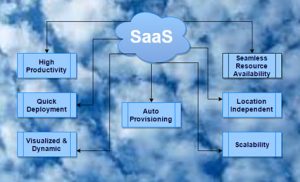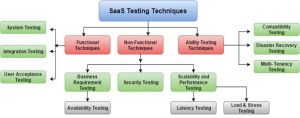Introduction
More than a decade ago, in the era when technology evolved to bring in virtualization in the mode of cloud computing, a funny reply came from the owner of an organization when one of his subordinates shared a thought on migrating their services to the cloud. The reply was, “I just don’t trust keeping our data in the cloud. Plus if we got rid of the server, where would we keep the coffee maker!!! ?”.
Later, after a decade, we witnessed that the cloud and its services became a game-changer and the deciding factor in the existence of many software organizations. Organizations can meet business demands in a quicker way and by achieving scalable costs by using Software as a Service, thus helping them to focus on their core business. Software as a Service (SaaS) testing using the cloud minimizes the hiccups that arise in traditional testing thereby providing infinite effective storage and flexibility via distributed environment.
What is SaaS Testing?
SaaS is a software distribution model in which applications are hosted by a vendor or service provider and made available to the customers over a network, typically the Internet.
SaaS Testing refers to the methods used to ensure that applications built using the software as a service model of development function as designed.
It also ensures the performance, security, and reliability of an application by leveraging the cloud-based infrastructure and computing resources to perform for a regular on-premise platform.
Objectives of SaaS Testing should be:
- SaaS deployments should take less time than on-premise software deployments.
- Software hosted on the cloud should be highly secure, scalable, and reliable.
- The extent to which the SaaS solution can be customized
Why SaaS Testing?
SaaS testing is intended to be a speedy and productive manner to get applications released to customers. In agile methodology testing and quality assurance (QA) has become more critical as applications are delivered more rapidly. Since the number of testing increases, more focus should be provided on the quality of the applications developed in a quick and efficient manner.
A. Efficient Load Testing
There will be times when we are unable to predict the number of users who use the application. So in order to perform efficient load testing, we can approach any cloud service where we can simulate users and easily scale up to the desired load to measure the performance of the application under a large number of concurrent users.
B. Replicate real-world usage
It also helps users’ data to be moved to large data centers, which are remotely located, with the user being able to access the same anytime needed.
C. Reduces the direct price of the equipment
It reduces the direct price of equipment maintenance and management and helps attain rapid ROI on application assets and brings about faster time to market.
Types of SaaS Testing
Functional Testing
SaaS Functional testing is performed for both remote and local applications. It consists of testing all features of the system including hardware and software testing. The different types of functional testing are System, Integration, and User Acceptance Testing.
Non-functional Testing
This type of testing is done to ensure that a web application meets the specified requirements; the way an application operates, rather than the specific behaviors of that application. It includes Security testing, Stress testing, Load Testing, and Performance Testing.
Ability Testing Techniques
Ability Testing Techniques ensure that the user receives appropriate services from the cloud environment on demand. Under this category, Compatibility and Interoperability Testing, Disaster Recovery Testing, and Multi-Tenancy testing are performed.
Testing as a Service in Clouds
TaaS aka Testing as a Service is a subset of a SaaS offering, allowing groups to outsource their entire test effort. With this model, the manpower and expertise required to execute the test are provided. This type of cloud testing is an approach that can also be used for specialized types of tests, such as performance, mobility, or security testing. The execution can be performed either on the client site or remotely from the outsourced provider’s test lab/facilities.
TaaS Architecture
Points to successful SaaS testing
Build your understanding of the cloud
Before moving your project to the cloud the objective and the strategy should be clearly defined. The organization or the management team should do formal research about the business needs and the limitation of moving the project to the cloud.
Formulate your testing strategy
The type of test and the risk involved during the test should be analyzed by creating a good test strategy. The duration of the usage of any cloud tool should be predefined and well-documented.
Select a service provider
A service provider has an enormous amount of experience and stability is the prime factor when choosing the vendor. License, cost, set-up, and tear down of the environment should be thoroughly scrutinized.
Execute the test
Companies should plan for optimal utilization of test infrastructure since it is a critical phase where applications are tested according to the defined test strategy.
Monitor and analyze test results
Test results should be monitored in real-time to understand and react to capacity – or performance-related issues.
Cloud Testing Tools
Needless to say, the emerging popularity of cloud testing has given rise to a set of cloud-based testing tools in the market. The right choice of testing tools depends on multiple parameters including application architecture, context, and customer needs. Here are some of the highly popular cloud-based software testing tools.
1. SOASTA Cloud Test
It enables four types of test automation on a single web platform – Mobile Functional & Performance testing and Web-based Functional & Performance testing.
2. LoadStorm
It is a load-testing tool for web and mobile applications. It is easy to use and cost-effective. It is ideal to check performance under excessive traffic or usage.
3. BlazeMeter
It is used for end-to-end performance and load testing of mobile apps, websites, and APIs. It is JMeter compatible and can simulate up to 1 million users.
4. Nessus
It is a widely used vulnerability scanner that can detect vulnerabilities, misconfiguration, and missing patches in a range of devices, firewalls, virtualized systems, cloud infrastructure, etc. You can use it to detect threats like viruses, malware, backdoors, and web services linking to malicious content.
5. Appthwack
It is a cloud-based simulator for testing Android, iOS, and web apps on actual devices. It is compatible with popular automation platforms like Robotium, Calabash, UI Automation, and several others.
6. Jenkins Dev@Cloud
It facilitates development, continuous deployment, and integration on the cloud. It allows development in many languages and deployment to any number of services. It provides a wide array of mobile tools for development and allows connecting securely to existing systems via the cloud.
7. Xamarin test cloud
It is a UI acceptance testing tool for mobile apps. It allows writing tests in C# using the NUnit testing library through the UITest framework or in Ruby through the Calabash framework.
Conclusion
Finally, it is true that many organizations are interested to adopt cloud test services because of their flexibility, scalability, and reduced costs. In the near future, large as well as small businesses will use cloud testing solutions on a large scale. Testing teams should be equipped with cloud tools and infrastructure with viable strategies to mitigate the risks and issues associated with cloud computing by obtaining additional capabilities available in the cloud computing environment. In the future, as the architecture for cloud computing gets more mature there is a possibility of more testing challenges. Evidently, the cloud is here to stay for a long time and cloud testing seems to have a bright future.



